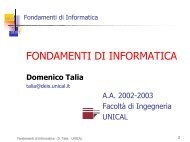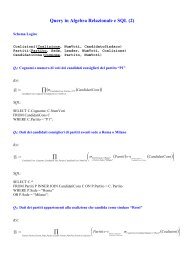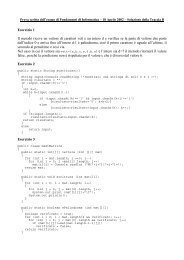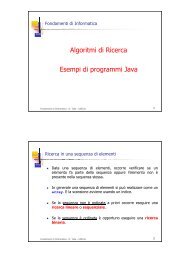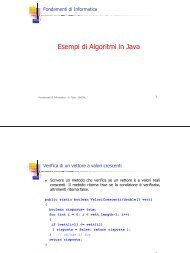Vandermonde systems on Gauss-Lobatto Chebyshev nodes
Vandermonde systems on Gauss-Lobatto Chebyshev nodes
Vandermonde systems on Gauss-Lobatto Chebyshev nodes
Create successful ePaper yourself
Turn your PDF publications into a flip-book with our unique Google optimized e-Paper software.
Polynomial interpolati<strong>on</strong> <strong>on</strong> several set of <strong>nodes</strong> has received much attenti<strong>on</strong>over the past decade [6]. Theoretically, any discretizati<strong>on</strong> grid can be used toc<strong>on</strong>struct the interpolati<strong>on</strong> polynomial. However, the interpolated soluti<strong>on</strong> betweendiscretizati<strong>on</strong> points are accurate <strong>on</strong>ly if the individual building blocksbehave well between points. Lagrangian polynomials with a uniform grid sufferfor the effect of the Runge phenomen<strong>on</strong>: small data near the center of theinterval are associated with wild oscillati<strong>on</strong>s in the interpolant, <strong>on</strong> the order2 n times bigger, near the edges of the interval, [7][8]. The best choice is touse <strong>nodes</strong> that are clustered near the edges of the interval with an asymptoticdensity proporti<strong>on</strong>al to (1 − x 2 ) −1/2 as n → ∞, [9]. The family of <strong>Chebyshev</strong>points, obtained by projecting equally spaced points <strong>on</strong> the unit circle down tothe unit interval [−1, 1] have such density properties. The classical <strong>Chebyshev</strong>grids are [10]:• <strong>Chebyshev</strong> <strong>nodes</strong>T 1 ={x k = cos• Extended <strong>Chebyshev</strong> <strong>nodes</strong>[ ]}2k − 12n π , k = 1, 2,...,n⎧⎨T 2 =⎩ x k = − cos ( ⎫2k−12n π)⎬cos ( ) , k = 1, 2,...,nπ⎭2n• <strong>Gauss</strong>-<strong>Lobatto</strong> <strong>Chebyshev</strong> <strong>nodes</strong> (extrema)T 3 ={x k = − cos[ ]}k − 1n − 1 π , k = 1, 2,...,n(1)(2)(3)In [11] it is proved that interpolati<strong>on</strong> <strong>on</strong> the <strong>Chebyshev</strong> polynomial extremaminimizes the diameter of the set of the vectors of the coefficients of all possiblepolynomials interpolating the perturbed data. Although the set of <strong>Gauss</strong>-<strong>Lobatto</strong> <strong>Chebyshev</strong> <strong>nodes</strong> failed to be a good approximati<strong>on</strong> to the optimalinterpolati<strong>on</strong> set, such set is of c<strong>on</strong>siderable interest since the norm of corresp<strong>on</strong>dinginterpolati<strong>on</strong> operator P n (T 3 ) is less than the norm of the operatorP n (T 1 ) induced by interpolati<strong>on</strong> at the <strong>Chebyshev</strong> roots [12].This paper deals with <str<strong>on</strong>g>Vanderm<strong>on</strong>de</str<strong>on</strong>g> matrices <strong>on</strong> <strong>Gauss</strong>-<strong>Lobatto</strong> <strong>Chebyshev</strong><strong>nodes</strong>. Through the paper we present a factorizati<strong>on</strong> of the inverse of such matrixand derive an algorithm for solving primal and dual system. We also giveasymptotic estimates of the Frobenius norm of both V n and its inverse and anexplicit formula for det(V n ). A point of interest in this matrix is the (relative)moderate growth, versus n, of the c<strong>on</strong>diti<strong>on</strong> number κ 2 (V n ), [13][3]. Figure 1shows the κ 2 comparis<strong>on</strong> between the <str<strong>on</strong>g>Vanderm<strong>on</strong>de</str<strong>on</strong>g> matrix <strong>on</strong> the <strong>Chebyshev</strong><strong>nodes</strong> (V n (T 1 )), <strong>Chebyshev</strong> extesa <strong>nodes</strong> (V n (T 2 )) and <strong>Gauss</strong>-<strong>Lobatto</strong> <strong>Chebyshev</strong><strong>nodes</strong> (V n (T 3 )).2




